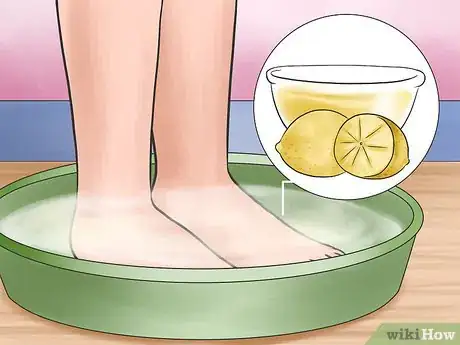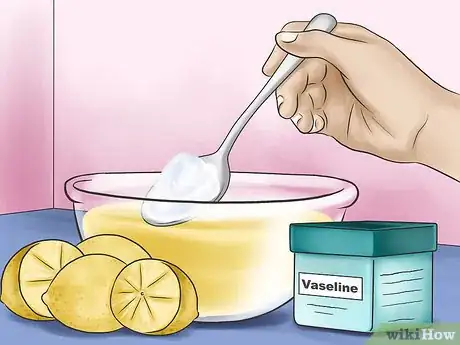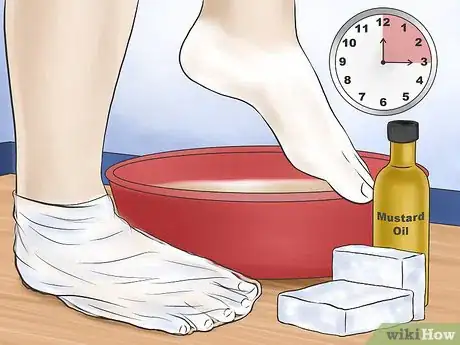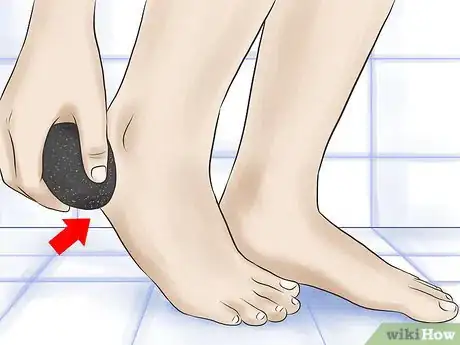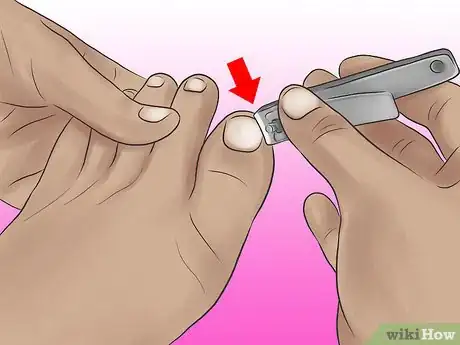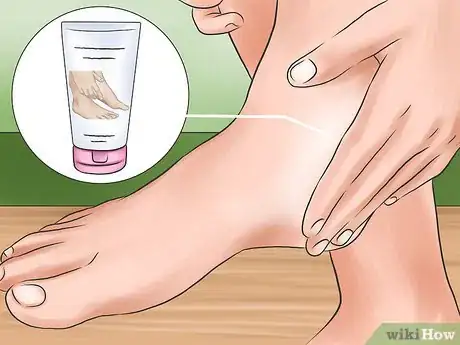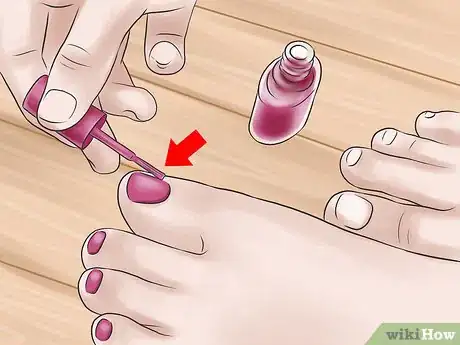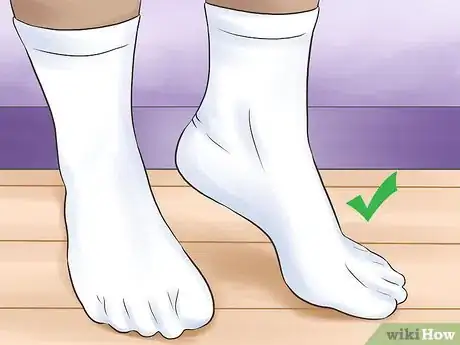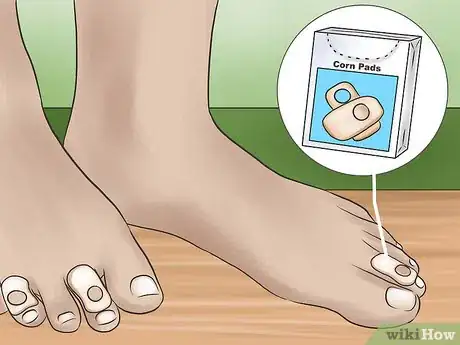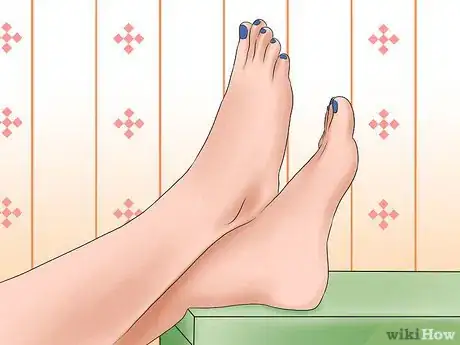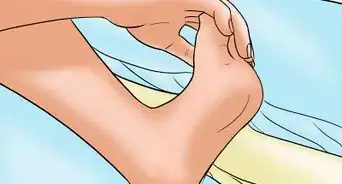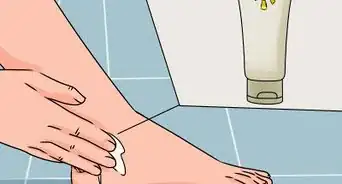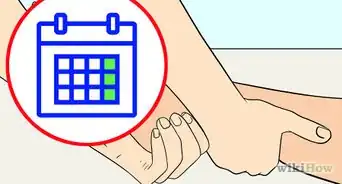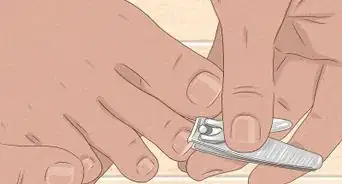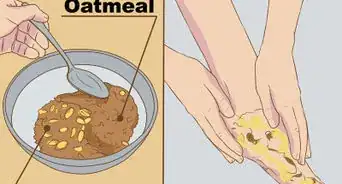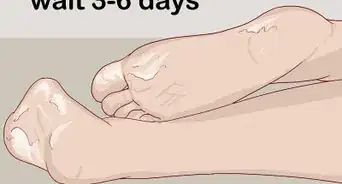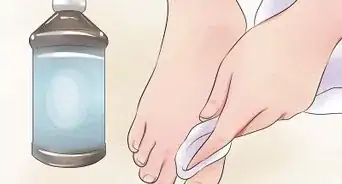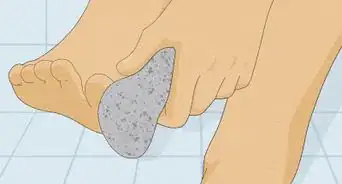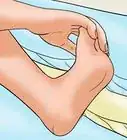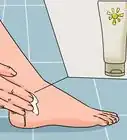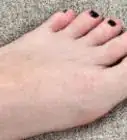This article was medically reviewed by Catherine Cheung, DPM. Dr. Catherine Cheung is a board certified Podiatrist based in San Francisco, California. Dr. Cheung specializes in all aspects of foot and ankle care, including complex reconstruction. Dr. Cheung is affiliated with the Brown & Toland Physicians and the Sutter Medical Network. She earned a DPM from the California College of Podiatric Medicine, completed her residency at the Encino Tarzana Medical Center, and completed a fellowship at the Kaiser Permanente San Francisco Medical Center. She is board certified by the American Board of Podiatric Surgery.
There are 13 references cited in this article, which can be found at the bottom of the page.
wikiHow marks an article as reader-approved once it receives enough positive feedback. In this case, 80% of readers who voted found the article helpful, earning it our reader-approved status.
This article has been viewed 448,223 times.
Our feet are some of the hardest working body parts we have, so it's a good idea to take excellent care of them! There are a number of things we can do to help provide our feet with extra care, including removing dead skin and calluses from the bottom of our feet. It should be noted, however, that using a razor or very sharp cutting device on your feet - to help remove dead skin or calluses - can be dangerous. Use instruments like pumice stones and foot files, rather than razors, to remove the dead and dry skin from your feet.
Steps
Pampering Your Feet at Home
-
1Soak your feet in lemon juice. A foot soak in lemon juice for about 10 minutes is a great way to remove excess dead and dry skin from your feet. The acid in the lemon juice helps make the dead and dry skin easier to remove. After your feet have soaked for the 10 minutes, use a pumice stone or foot file to remove the dead and dry skin.[1]
- Foot razors/shavers are available for purchase at many drug and department stores, but are not recommended by doctors. They have also become illegal to use in a spa setting in many states. The reason is that they can cause nicks and cuts on your feet which can very easily become infected - especially in a spa environment.[2]
-
2Make your own cracked-heel cream. Put a spoonful of olive oil in a small bottle with a lid. Add a few drops of lemon or lavender oil to the bottle. Place the lid tightly on the bottle and shake until the liquid inside the bottle turns thick and milky. Apply to your feet, especially your heels, to help moisturize your skin. You can store the bottle for future use, just remember to shake it each time.[3]Advertisement
-
3Oil your feet before bed. Start by having a bath or shower where you wash your feet, or wash your feet on their own. Dry your feet off with a towel, including between your toes. Apply a layer of vegetable oil all over your feet and then put on a thick pair of socks. Go to bed and leave the socks on. You may find your dry feet feeling a lot better in only a few days.[4]
- The oil may stain fabric, like your socks, so choose a pair of socks you don't mind if they get stained by the oil. The socks will also help prevent your sheets from being stained by the oil.
-
4Create your own overnight foot mask. Combine 1 tablespoon (14.8 ml) of Vaseline (or a similar product) and the juice from 1 lemon into a bowl, then mix the two ingredients together. Either have a bath or shower where you wash your feet, or just wash your feet on their own. Dry your feet completely with a towel. Apply ALL the mixture to both your feet, then put on a pair of thick wool socks. Go to bed. In the morning, take off the socks and scrub the excess dead skin off your feet.[5]
- Wool socks are used in this case as they won't allow the mixture to soak through and stain your bedsheets. Choose socks that you don't mind if they get this oily mixture on them.
-
5Try paraffin wax to moisturize your feet. First, melt the wax in a large bowl in the microwave (or a double boiler if you have one). Add an equal amount of mustard oil to the melted wax. Check to make sure that the wax is safely warm to the touch before dipping one foot into the bowl and covering your foot with the wax mixture. Take your foot out of the bowl and allow the wax to dry, then dip the same foot again. Wrap your foot in plastic wrap, or put it inside a plastic bag. Repeat the same procedure on your other foot. Sit for about 15 minutes, then remove the wax and plastic.[6]
- Mustard oil helps to strengthen and moisturize the skin on your feet.
Performing Your Own Pedicure
-
1Soak your feet. First, you need to find or buy a large enough tub in which both of your feet can rest comfortably, and deep enough that your feet can be covered in water. Put a few drops of mild soap into the tub and fill half way with warm water. You can also try adding a few drops of your favourite essential oil to the water to add some aromatherapy while you relax. Sit on a comfortable chair and soak your feet in the water for 10 minutes.[7]
- Use a 1 cup of epsom salts instead of the soap. Epsom salts are actually a mineral made with magnesium and sulphate. Both magnesium and sulphates have excellent health benefits, and both are absorbed quickly through the skin. This makes an epsom salt soak a great way to get magnesium and sulphate into your body. Both minerals have benefits such as: increased serotonin production, increased energy, reduced inflammation, foot odour elimination, and improved blood circulation.[8]
- Use 1/4 cup of white vinegar instead of the soap. Vinegar has a lot more benefits than many realize, and many of those benefits are not in the kitchen. Soaking your feet in a vinegar mixture can help eliminate foot odour, and reduce your chances of getting a foot fungus like athlete's foot. Vinegar is also acidic, which helps soften the skin, making it easier to remove dead and dry skin after you're finished soaking.[9]
-
2Remove dead skin and calluses. Use a pumice stone to scrub the dead skin and calluses off the bottoms of your feet. You may need to bend your feet behind you in order to reach all the way around your heals. Don't forget to check your toes for calluses and dead skin as well.[10]
- Remember to wet the pumice stone before using it.[11]
- Using a skin-softener cream and a pumice stone will help remove dead skin from your feet, leaving them soft and smooth.
Warning: Foot razors and shavers are available for purchase at many drug and department stores, they are not recommended by doctors. Unfortunately it is too easy to cut or nick your feet with a foot razor, which can lead to infections.[12]
-
3Take care of your cuticles and nails. Use wooden manicure stick to push back the cuticles on each of your toenails. Then, using either large-sized nail clippers, or specialty nail clippers, trim each of your toenails. If you decide to leave your toenails a little longer, make sure they do not go beyond the edge of your toe. In addition, cut your nails evenly along the whole width of the nail. Do not cut the nail such that the edges curve in or down. This can cause ingrown nails which can be painful.[13] File the edges of your nail with a nail file or emery board after you've trimmed them.
- Take care not to cut your nails too far back, as you could accidentally cut into your skin.
-
4Moisturize your feet and ankles. Massage a good quality moisturizer into each of your feet, including your toes and nails. Consider using a rolling pin or foot massager before or after you've applied the moisturizer to massage your feet even further.[14] Feel free to use a decent amount of moisturizer on your feet during this step - but be careful about walking around afterwards if the cream hasn't fully soaked into your skin.
-
5Polish your nails. If you want to apply nail polish to your toenails, start by using a small amount of nail polish remover to remove any excess moisturizer that may be on your nails. Then apply a clear base coat to each nail and allow it to set before applying anymore layers. Apply 1-2 layers of a coloured nail polish, allowing each layer to set before moving onto the next layer. Finally, apply a clear top coat to each nail.[15] Once all layers are applied, allow the polish to dry for as long as possible before slipping your feet into socks or shoes. Walking around in bare feet or open-toe sandals might be best until you're sure the polish has dried.
- Nail polish remover comes in acetone and non-acetone versions. The acetone version works better at removing nail polish, but it is also harsher on your skin and nails. If you're prone to dry and brittle nails, and/or you remove nail polish a lot, you may want to use the non-acetone version. The non-acetone version is gentler on your skin and nails, but may take a little more 'elbow grease' to remove the nail polish.[16]
Taking Care of Your Feet
-
1Select the proper shoes. One of the best things you can do for your feet is to buy and wear the proper shoes. Shoes that are ill fitting create friction and pressure, which cause calluses, corns, and dryness to form.[17] There are several things you can do to make sure you find the proper shoe.[18]
- Get both of your feet measured. You probably have one foot that is larger than the other. You need to find shoes that will fit the larger of your two feet.
- Go shoe shopping at the end of the day, as that is when your feet are at their largest. Sizing your shoes later in the day makes sure your shoes don't get tighter throughout the day as your feet swell.
- Don't depend on the manufacturer's size. Base your judgement on how the shoe actually feels.
- Look for shoes that have the same shape as your feet. Oddly shaped shoes will most likely cause you problems.
- Don't assume shoes will stretch after you've worn them awhile.
- Make sure the balls of your feet are comfortable in the widest part of the shoe. And that the shoe is deep enough to fit your toes comfortably.
- Check that there is 3/8” to 1/2” of space between the end of your big toe and the shoes. You can estimate this as the width of your finger, while you're standing.
-
2Keep your feet dry. Try to wear only soft cotton socks inside your shoes, especially when doing a physical activity. Allow your shoes to completely dry out after physical activities that cause your feet to sweat excessively. Don't wear the same socks two days in a row. Change your socks throughout the day if they get wet or sweaty. Wash your feet every day, including in between your toes, to prevent conditions like athlete's foot. And completely dry your feet before putting socks on. Taking these precautions will help you avoid bad foot odor as well as development of rashes and eczema.[19]
- Try to avoid wearing the same pair of shoes each day to give your shoes time to dry out.
- If you wear closed-toe shoes for work, switch to sandals when you get home.
- It is also a good idea to wear flip-flops or another type of sandal when in public areas like a swimming pool or public shower.[20]
-
3Moisturize your feet every day. The best way to prevent your feet from getting dry and cracked is to make sure you apply a good quality foot moisturizer to them every day.[21] Moisturizing your feet is especially important in the winter when the air is cold and dry. Be careful that you don't apply moisturizer and then attempt to walk around in your bare feet on a tile or wood floor. You may find that applying moisturizer just before bed is the easiest, and possibly safest, habit to get into.
- Use your moisturizing time to give yourself a foot massage. Massaging your feet not only feels good, but it can help with blood circulation.
- Avoid showering or bathing in really hot water, which can dry out your skin faster.[22]
- Use moisturizer designed specifically for feet as other types of moisturizers may contain alcohol, which can dry out your skin more quickly.
-
4Work to avoid and remove corns. Interestingly, the majority of foot problems are not caused by the fact that you're walking, but rather because of your shoes. Corns (which are calluses that form on your toes) are caused when your toes rub against the inside of your shoes, mainly because your shoes (or socks) are not the proper size. High heels can also cause corns because their shape forces extra pressure onto your toes and forefoot, which in turn causes your toes to push up against the inside of your shoes more often. You can help prevent and treat corns at home, but if they become severe, you will need to see a doctor.[23]
- Soak your feet in warm water regularly, and use a pumice stone to remove dead skin and calluses from your toes and feet.
- Wear 'corn pads' on your toes to help cushion them within your shoes. Medicated 'corn pads' are not recommended.
- Switch to shoes that fit your feet properly and have plenty of room in the toes. Reduce your use of high heels if possible.
-
5Put your feet up. It is actually doctor recommended, so go ahead and put your feet up when you can! Having said that, if you do find yourself sitting for a long time, take a moment to get up and walk around. And if you have a habit of crossing your legs while you're sitting, change which way you cross them every so often. All of these tips are a great way to help increase the circulation in your legs and feet.
- This is particularly helpful if your foot is in pain. Elevating your foot should help relieve any pain you’re experiencing.[24]
Expert Q&A
Did you know you can get expert answers for this article?
Unlock expert answers by supporting wikiHow
-
QuestionCan you cut dead skin off your feet?
 Catherine Cheung, DPMDr. Catherine Cheung is a board certified Podiatrist based in San Francisco, California. Dr. Cheung specializes in all aspects of foot and ankle care, including complex reconstruction. Dr. Cheung is affiliated with the Brown & Toland Physicians and the Sutter Medical Network. She earned a DPM from the California College of Podiatric Medicine, completed her residency at the Encino Tarzana Medical Center, and completed a fellowship at the Kaiser Permanente San Francisco Medical Center. She is board certified by the American Board of Podiatric Surgery.
Catherine Cheung, DPMDr. Catherine Cheung is a board certified Podiatrist based in San Francisco, California. Dr. Cheung specializes in all aspects of foot and ankle care, including complex reconstruction. Dr. Cheung is affiliated with the Brown & Toland Physicians and the Sutter Medical Network. She earned a DPM from the California College of Podiatric Medicine, completed her residency at the Encino Tarzana Medical Center, and completed a fellowship at the Kaiser Permanente San Francisco Medical Center. She is board certified by the American Board of Podiatric Surgery.
Board Certified Podiatrist
-
QuestionCan diabetics use a foot file?
 Catherine Cheung, DPMDr. Catherine Cheung is a board certified Podiatrist based in San Francisco, California. Dr. Cheung specializes in all aspects of foot and ankle care, including complex reconstruction. Dr. Cheung is affiliated with the Brown & Toland Physicians and the Sutter Medical Network. She earned a DPM from the California College of Podiatric Medicine, completed her residency at the Encino Tarzana Medical Center, and completed a fellowship at the Kaiser Permanente San Francisco Medical Center. She is board certified by the American Board of Podiatric Surgery.
Catherine Cheung, DPMDr. Catherine Cheung is a board certified Podiatrist based in San Francisco, California. Dr. Cheung specializes in all aspects of foot and ankle care, including complex reconstruction. Dr. Cheung is affiliated with the Brown & Toland Physicians and the Sutter Medical Network. She earned a DPM from the California College of Podiatric Medicine, completed her residency at the Encino Tarzana Medical Center, and completed a fellowship at the Kaiser Permanente San Francisco Medical Center. She is board certified by the American Board of Podiatric Surgery.
Board Certified Podiatrist
-
QuestionHow do you stop foot odor?
 Catherine Cheung, DPMDr. Catherine Cheung is a board certified Podiatrist based in San Francisco, California. Dr. Cheung specializes in all aspects of foot and ankle care, including complex reconstruction. Dr. Cheung is affiliated with the Brown & Toland Physicians and the Sutter Medical Network. She earned a DPM from the California College of Podiatric Medicine, completed her residency at the Encino Tarzana Medical Center, and completed a fellowship at the Kaiser Permanente San Francisco Medical Center. She is board certified by the American Board of Podiatric Surgery.
Catherine Cheung, DPMDr. Catherine Cheung is a board certified Podiatrist based in San Francisco, California. Dr. Cheung specializes in all aspects of foot and ankle care, including complex reconstruction. Dr. Cheung is affiliated with the Brown & Toland Physicians and the Sutter Medical Network. She earned a DPM from the California College of Podiatric Medicine, completed her residency at the Encino Tarzana Medical Center, and completed a fellowship at the Kaiser Permanente San Francisco Medical Center. She is board certified by the American Board of Podiatric Surgery.
Board Certified Podiatrist
Warnings
- People with diabetes are required to take extra special care of their feet. If you are diabetic, please follow your doctor's instructions as to foot care.[25]⧼thumbs_response⧽
References
- ↑ http://www.footvitals.com/skin/dry-feet.html
- ↑ http://feet.thefuntimesguide.com/2008/06/pedicure_foot_razors.php
- ↑ http://www.footvitals.com/skin/dry-feet.html
- ↑ http://www.footvitals.com/skin/dry-feet.html
- ↑ http://www.footvitals.com/skin/dry-feet.html
- ↑ http://www.newhealthguide.org/Cracked-Feet.html
- ↑ http://www.aofas.org/footcaremd/how-to/foot-health/Pages/How-to-Practice-Good-Foot-Hygiene.aspx
- ↑ https://www.epsomsaltcouncil.org/wp-content/uploads/2015/10/universal_health_institute_about_epsom_salt.pdf
- ↑ http://www.newhealthguide.org/Vinegar-Foot-Soak.html
- ↑ Catherine Cheung, DPM. Board Certified Podiatrist. Expert Interview. 21 April 2019.
- ↑ http://www.newhealthguide.org/Cracked-Feet.html
- ↑ Catherine Cheung, DPM. Board Certified Podiatrist. Expert Interview. 21 April 2019.
- ↑ http://www.aofas.org/footcaremd/how-to/foot-health/Pages/How-to-Practice-Good-Foot-Hygiene.aspx
- ↑ http://www.aofas.org/footcaremd/how-to/foot-health/Pages/How-to-Practice-Good-Foot-Hygiene.aspx
- ↑ http://www.aofas.org/footcaremd/how-to/foot-health/Pages/How-to-Practice-Good-Foot-Hygiene.aspx
- ↑ http://www.self.com/flash/nutritionnews/2012/03/to-acetone-or-not-the-healthie/
- ↑ http://www.mayoclinic.org/diseases-conditions/corns-and-calluses/symptoms-causes/dxc-20317257
- ↑ http://www.aofas.org/footcaremd/how-to/footwear/Pages/10-Points-of-Proper-Shoefit.aspx
- ↑ Catherine Cheung, DPM. Board Certified Podiatrist. Expert Interview. 21 April 2019.
- ↑ http://www.nhs.uk/Livewell/foothealth/Pages/Healthyfeet.aspx
- ↑ http://www.ageuk.org.uk/health-wellbeing/keeping-fit/fitter-feet/
- ↑ http://www.footvitals.com/skin/dry-feet.html
- ↑ http://www.aofas.org/footcaremd/conditions/ailments-of-the-big-toe/Pages/Corns-and-Calluses.aspx
- ↑ Catherine Cheung, DPM. Board Certified Podiatrist. Expert Interview. 21 April 2019.
- ↑ Catherine Cheung, DPM. Board Certified Podiatrist. Expert Interview. 21 April 2019.
About This Article
To shave dead skin off of your feet, start by soaking your feet in a tub of warm water for 10 minutes. You can also add 1/4 cup of white vinegar to the water, which will help soften your dead skin so it's easier to remove. After 10 minutes, take your feet out of the tub and scrub the dead skin with a pumice stone or foot file. Once you've scrubbed off all of the dead skin, massage some moisturizer into your feet. To learn how to take care of your feet and avoid dead skin, scroll down!
